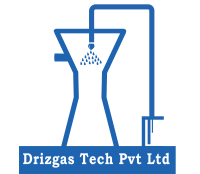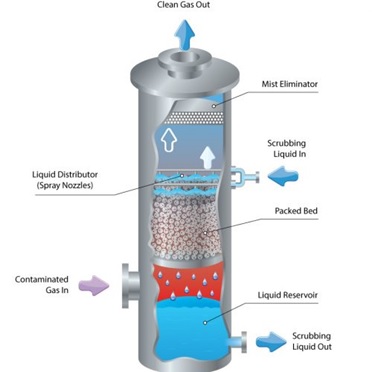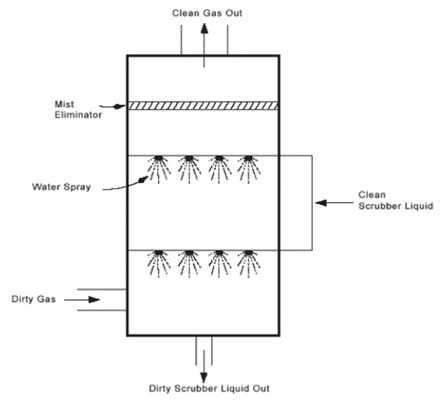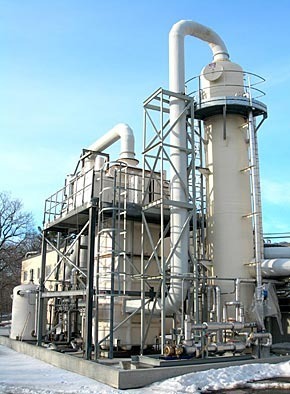Wet Scrubber overview
Drizgas Tech is specialists in all types of wet scrubber system. We are the leading manufacturer of wet scrubber in India for various industrial application.
Introduction to Industrial Scrubbers
If you are a plant manager, a process engineer, or Environmental Health and Safety (EHS) Engineer who works in manufacturing industries or wastewater treatment industry, then you may be looking for a solution to remove harmful chemicals, pollutants and odors from your process exhaust streams before they are released into the atmosphere and contaminate the outside air. One technology worth to consider strongly is the industrial scrubber. Industrial scrubber is an air pollution control systems that utilize solids in dry scrubbers, or water or other liquids in wet scrubbers to remove gas pollutants and odors from exhaust streams.
In general, the main advantages of industrial wet scrubbers to clean gas exhaust streams include:
- Ability to absorb gas and solid particulate matter using single device
- Ability to neutralize corrosive gases
- No secondary dust sources – once particulate matter is collected, it cannot escape from the scrubber
- Low-risk for scrubbing incendiary (flammable) gases
- Ability to handle high temperature, high humidity gas streams without temperature limit or condensation problems
- Small space requirements mean lower capital costs and site location flexibility – scrubbers reduce the temperature and volume of unsaturated exhaust streams, permitting vessel sizes, fans and ducts to be more compact. This also enables retro-fitting into existing systems
Dry vs Wet Scrubbers
Industrial scrubbers are categorized as either dry or wet scrubber. Dry scrubbers remove pollutants by “Adsorption” principle using dry solid media/activated carbon or adsorbent without utilizing water or solvent. Dry scrubbers are well suited for applications in facilities that lack the infrastructure to properly handle produced wastewater. Dry scrubbers remove pollutants from exhaust gases without the use of liquids. Instead, they utilize a dry reaction material known as sorbent, such as alkaline slurry, and they are primarily implemented for removal of acid from gas by moving the gas through the sorbent to maximize binding.
In contrast to dry scrubbers, wet scrubbers remove contaminated gas through liquid that is designed to remove pollutants. Wet scrubbers constitute a versatile and cost-effective pollution control technology that can eliminate up to 99% of gaseous pollutants and particulate matter.
| Dry scrubber | Wet scrubber |
| Removes pollutants using “Adsorption” principle | Removes pollutants using “Absorption” principle |
| Uses dry solid media to capture pollutants | Uses water or chemical solvent to capture pollutants |
| Does not produce waste water | It produces waste water or slurry |
| Suitable for pollutants, which can be trapped by activated carbon/dry media | Suitable for water soluble pollutants |
| Suitable for low pollutant load (less than 5000 ppm) | Suitable for high pollutant load (more than 5000 ppm) |
| Efficiency can be achieved up to 99.9 % | Efficiency can be achieved up to 99 % |
How Wet scrubbers work
Water is the most common solvent used to remove inorganic contaminants. In the most basic form of wet scrubbers, water is encapsulated in a metal or composite container, contaminated gas is moved through the water, the water then absorbs the contaminates, and clean gas exits the scrubber.
Aside from water, other liquids can be used as absorbing solutions to effectively remove varied contaminates. Manipulating the chemical composition of the absorbing solutions changes the overall charge, which can be highly positively charged, negatively charged, or non-charged. Because pollutants differ in their charge, wet scrubbers are packed with the liquid that will bind most effectively to remove the contaminants from the gas. Caustic solution (sodium hydroxide, NaOH) is the most common scrubbing liquid used for acid-gas control (e.g., HCl, SO2, or both), though sodium carbonate (Na2CO3), calcium hydroxide (slaked lime, Ca[OH]2), Potassium Hydroxide (KOH) are also used.
Wet Scrubbing of Particulate Matter
Wet scrubbers can remove particulate matter by capturing them in liquid droplets. The droplets are then collected, with the liquid dissolving or absorbing the pollutant gases. Any droplets that are in the scrubber inlet gas must be separated from the outlet gas stream using a mist eliminator. Also, the resultant scrubbing liquid must be treated prior to any ultimate discharge or being reused in the plant.
A wet scrubber’s ability to collect particulate matter is often directly proportional to the power input into the scrubber. Additionally, a properly designed and operated mist eliminator is important to achieve high removal efficiencies.
If the gas stream contains both particulate matter and gases, wet scrubbers are generally the only single air pollution control device that can remove both gaseous pollutants and particulate matter.
Major type of scrubber
It is classified based on working principle
- Packed bed scrubber
- Venturi scrubber
- Spray tower scrubber
Packed-Bed Wet Scrubbers
Wet scrubbers that remove gaseous pollutants are referred to as absorbers. Gas-to-Liquid contact is essential to obtain high removal efficiencies in absorbers. Various wet scrubber designs are used to remove gaseous pollutants, with one of the most popular sub categories of wet scrubber known as Packed bed, Packed tower scrubber.
Although they can also collect solid particulate matter, packed bed scrubbers are generally used more for the treatment of gas. Packed bed scrubbers are typically used in the chemical, aluminum, coke and ferroalloy, food and agriculture, and chromium electroplating industries, in acid plants, fertilizer plants, steel mills, and asphalt plants.
Applicable Pollutants for Packed-Bed Wet Scrubbers
Packed bed wet scrubbers are used to control:
Inorganic fumes, vapors, and gases (e.g., chromic acid, hydrogen sulfide, ammonia, chlorides, fluorides, and SO2) – Inorganic fumes, vapors and gases are the primary pollutants controlled by Packed-Bed wet scrubbers. They typically achieve removal efficiencies in the range of 95 to 99%.
Volatile Organic Compounds (VOC) – Wet scrubbers are occasionally used to control volatile organic compounds (VOCs). Removal efficiencies for gas absorbers vary for each pollutant-solvent system and with the type of absorber used. Most absorbers have removal efficiencies in excess of 90%, and packed tower absorbers may achieve efficiencies greater than 99% for some pollutant-solvent systems. The typical collection efficiency range is from 70% to greater than 99%.
Particulate Matter (PM) and Hazardous Air Pollutants (HAP) in particulate form (PMHAP) – Packed-bed wet scrubbers are limited to applications in which dust loading is low, and collection efficiencies range from 50-95 %, depending upon the application.
How Packed bed scrubbers operate
Packed bed scrubbers remove air pollutants through inertial or diffusional impaction, reaction with a sorbent or reagent slurry, or absorption into liquid solvent.
Packed bed scrubbers consist of a chamber containing layers of variously shaped packing material (e.g.,Pall rings, Intalox saddle) that provides a large surface area for liquid-gas contact. The packing’s shape, weight, surface area and cost all influence the efficiency of the low gas-phase pressure drop and high gas-liquid contact. The packing is held in place by wire mesh retainers, and is supported by a plate near the bottom of the scrubber.
Waste gas is forced into the bottom of the scrubber’s chamber and flows vertically or horizontally through the packing while scrubbing liquid is simultaneously and evenly introduced above the packing and flows down through the bed to coat the packing and establish a thin film. In vertical designs (packed towers), the gas stream flows up the chamber (“counter-current” to the liquid). However, some packed beds are designed horizontally for gas flow across the packing (“cross-current”).
The cleaned gas is then passed through a mist eliminator built into the top of the structure, and the waste slurry drops to the bottom of the chamber.
Advantages of Packed-Bed Wet Scrubbers
- Relatively low pressure drop – Pressure drop is the pressure difference that occurs as exhaust gas is pushed or pulled through the scrubber, disregarding the pressure that would be used for pumping or spraying the liquid into the scrubber.
- Fiberglass-reinforced plastic (FRP) construction permits operation in highly corrosive atmospheres
- Capable of achieving relatively high mass-transfer efficiencies
- The height and/or type of packing can be changed to improve mass transfer without purchasing new equipment
- Relatively low capital cost
- Relatively small space requirements
- Ability to collect Particulate Matter (PM) as well as gases
Disadvantages of packed-bed towers
- May create water (or liquid) disposal problem
- Waste product collected wet
- Particulate Matter may cause plugging of the bed or plates
- When FRP construction is used, it is sensitive to temperature
Venturi Scrubbers
Another popular type of wet scrubber is the Venturi scrubber. Venturis can be used to collect both particulate and gaseous pollutants, but they are more effective in removing particles than gaseous pollutants. With Venturi scrubbers, the dirty gas entering a scrubber is forced at high velocity through a Venturi where it collides with scrubbing water. The tiny water droplets capture particles through impaction and diffusion. The mist eliminator for a Venturi scrubber is often a separate device called a cyclonic separator. The dirty water is then removed in the cyclonic separator and discharged into a recycle tank. Some of the liquid is continuously purged to limit the solids concentration and allow recirculation back to the Venturi section.
A Venturi scrubber typically consists of three sections:
- Converging section – Inlet gas stream enters the converging section and, as the area decreases, gas velocity increases. Liquid is introduced either at the throat or at the entrance to the converging section.
- Throat section – In the small throat section, the inlet gas is forced to move at extremely high velocities in the small throat section, and shears the liquid from its walls, producing an enormous number of very tiny droplets.
- Diverging section – in the diverging section, particle and gas removal occurs as the inlet gas stream mixes with the fog of tiny liquid droplets. The inlet stream then exits through the diverging section, where it is forced to slow down.
Classification of venturi scrubbers
Eductor Venturi Scrubbers
- Eductor scrubbers are designed to remove soluble gases and particulate by inducing a gas flow using high pressure liquid focused into a Venturi throat, which eliminates the need for a separate exhaust fan or blower to transport the contaminated gas stream to the filtration device.
- Design incorporates a high pressure spray for maximum entrainment and scrubbing efficiency, and is the optimal choice where high temperatures, heavy contaminant loads, and corrosive conditions are present.
- Maximum efficiency – up to 99% removal efficiency of mists 3 microns or larger
Wet Particulate Venturi Scrubbers
- Static pressure induced by an exhaust fan draws the sump water and dust-laden air stream into an inverted Venturi throat.
- Turbulent mixing of dust and small droplets form an agglomerate, which is returned to sump where water is reused and particulate matter settles out or is dissolved.
- Entrained mists and dust are collected on a chevron blade mist eliminator.
- The collected dust forms sludge at the conical bottom of the scrubber.
- High efficiency >99% on very fine particulates
- Energy savings – no pumps
- Maintenance savings – no moving parts, spray nozzles, or recirculation piping
- Floor space – efficient geometry
- Water savings – integral water saving sludge concentrator, the sump liquor need not be diluted
- Ideal applications include:
- Aluminum, titanium and other metal machining operations
- Sodium Azide propellant manufacturing and handling
- Pharmaceutical powders and dusts
- Calcium chloride dusts, Hygroscopic dusts
- Corrosive dusts, Food processing with Clean in Place (CIP) option
- Bulk solids drying process, Battery lead pasting
Advantages of venturi scrubber
- Relatively low maintenance
- High removal yield
- Simple and compact construction
- No mechanical components
- Gaseous components are absorbed
- Able to deal with fluctuating gas flows
- No ventilator required
Disadvantages of venturi scrubber
- Large pressure drops
- Signs of erosion when scrubbing abrasive mediums
Spray tower scrubber
Spray towers are very simple, low-energy wet scrubbers. In these scrubbers, the particulate-laden gas stream is introduced into a chamber where it comes into contact with liquid droplets generated by multiple spray zones. These scrubbers are also known as pre-formed spray scrubbers, since the liquid is formed into droplets prior to contact with the gas stream. The size of the droplets generated by the spray nozzles is controlled to maximize liquid-particle contact and, consequently, scrubber collection efficiency.
Spray towers are cylindrical or rectangular chambers that can be installed vertically or horizontally. In vertical spray towers, the gas stream flows up through the chamber and encounters several sets of spray nozzles producing liquid droplets. A de-mister at the top of the spray tower removes liquid droplets and wetted PM from the exiting gas stream. Scrubbing liquid and wetted PM also drain from the bottom of the tower in the form of slurry. Horizontal spray chambers operate in the same manner, except for the fact that the gas flows horizontally through the device.
The advantages of spray tower scrubber are
- Simple performance
- No risk on clogging and pollution in the wash section
- Beside dust also gaseous components are broken away from
- Available in several construction material
- Insensitive for fluctuating gas flows
- Low pressure drops
- Requires little place
The disadvantages are
- The performance with spray nozzles with small openings requires a clean wash fluid
- Are possible clogging in the adjudges with a very large efficiency loss as result
- Little efficiently for the disposal of fine dust particles
- The mass transfer is little efficient
Spray scrubbers are used in a variety of applications, including:
- The chemical industry, to separate dust and aerosols
- The metal industry for various types of waste gases
- Waste incineration installations
- Gasification processes
- Potato-processing industry for the removal of starch
- Glass industry
- Melting processes in metallurgy
- Foundries
- Sintering processes
- Drying processes
- Fertilizer production
- Pharmaceutical industry
- Plastics industry



